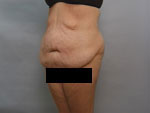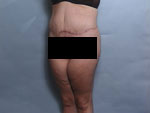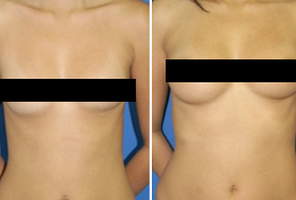Body lift procedures were developed to tone and tighten the body during one reconstructive process rather than many. Body lifts shape the body to better reflect a toned and tightened appearance which may be warranted after gastric bypass weight loss procedures, extreme weight loss due to diet & exercise, aging, or pregnancy.
Body contouring is a term that refers to cosmetic surgery procedures that are performed to make a dramatic improvement in the entire body's contour. Body contouring is often used for patients who have successfully lost a considerable amount of weight and have excess skin which must be tightened due to a loss of elasticity. Body contouring may also include the removal of unwanted pockets of fat that remained unaffected by weight loss.
A body lift incorporates different cosmetic procedures which tighten and tone various parts of the body. These procedures may include: tummy tuck, inner and outer thigh lift, and buttock lift. Excess skin is removed from the abdomen, thighs and buttocks, and the abdominal muscles and skin are tightened. A total body lift often incorporates liposuction to achieve balance between the torso and thighs. The surgery is extensive, but the outcome may be gratifying for eligible patients. A tighter and more attractive body from front to back and side to side is often the end result.
Central Body Lift (Belt Lipectomy)
Either with increasing age or significant weight loss, excess skin and fatty tissue may accumulate, altering the shape of the body's contours. Where excess skin and fatty tissue are mild in the abdomen and lower back areas, a tummy tuck or liposuction procedures may even out the body's contours.
Where there is a more significant amount of excess skin and fatty tissue, especially where the excess is circular in nature involving the belly, hips, back, buttocks, and outer thighs, a more extensive procedure may be required. A Belt Lipectomy may offer more satisfactory results in such cases. Other names for this procedure include torsoplasty, circumferential torsoplasty, body lift, central body lift, lower body lift, circumferential panniculectomy, and circumferential lipectomy.
How is a Body Lift usually performed?
 |  |
| Before Body Lift | After Body Lift |
Lower body lift surgery may involve any of three procedures, depending on the patient's specific needs and goals. Improving excess skin in the inner thigh for example would require the patient to seek out an inner thigh lift. Excess skin and loss of skin elasticity in the buttock and outer thigh areas may warrant a buttock lift procedure. Similar symptoms in the abdominal area may be altered with the help of a tummy tuck. When all procedures are performed concurrently, it is called a total body lift.
An inner thigh lift involves an incision high on the inner thigh near the groin crease. During surgery, excess skin is removed and the remaining skin is re-suspended, leaving a tighter and more attractive inner thigh.
The outer thigh and buttock can be lifted through an incision across the back, above the buttock, from hip to hip. During surgery, excess skin is removed and the remaining skin is lifted, leaving a tighter and more attractive outer thigh and buttock.
A tummy tuck requires the removal of loose skin from the abdomen and tightening of the underlying muscles. The incision is made along the bikini line and the resulting scar is not usually visible in swimwear. Although the incision is limited to the lower abdomen, the skin of the entire abdomen is tightened and a more toned abdominal area is the result.
All procedures are typically performed under general anesthesia and usually involve an overnight stay in the hospital.
Who is a candidate for a Body Lift?
Total Body Lift™ surgery is usually an option for healthy individuals who have had significant weight loss and who suffer from excessive and non-elastic skin which alters the body's contours.
There are obviously other factors involved in candidacy and consulting with a professional plastic surgeon is the most reliable way to determine eligibility.
Who is not a candidate for a Body Lift?
Excess skin which develops after weight loss does not naturally re-shape itself to the body's new form. Thus a body lift procedure offers a tightening of these areas, though it is not meant for weight loss. Patients who are more than 50% over their ideal body weight may wish to seek out a change in diet and exercise routines and/or consult with a weight loss surgeon.
Patients who have scars from previous surgeries may not be candidates for this operation because of complications that may result from alterations in the blood supply to the skin. A professional plastic surgeon will determine eligibility at the time of consultation.
Medical conditions such as bleeding disorders, heart disease, hypertension, diabetes, asthma, hernias, or a history of smoking are of particular concern due to the extensive nature and prolonged recovery times of body lift procedures.
There are obviously other factors involved in candidacy and consulting with a professional plastic surgeon is the most reliable way to determine eligibility.
What are some potential risks associated with a Body Lift?
Body lift procedures require a great deal of forethought, planning and a willingness to commit to a complex process. 7-10 hours of surgery on average may be expected for the entire procedure and more than one surgeon may be assisting the patient during the surgery.
Some of the risks include excessive loss of blood, infection, and complications with prolonged exposure to anesthesia. There is also a risk of seroma formation, which is a fluid accumulation beneath the skin. This is usually treated by repeated needle aspirations.
Wound separation is another possible risk and careful postoperative management of the patient best avoids it. Deep vein thrombosis, or blood clot formation in the legs after surgery, can lead to pulmonary embolus, which is a blood clot that travels to the lungs. This is a dangerous complication and every attempt is made to prevent its occurrence. This involves making sure the patient walks as soon as possible after surgery.
Though incisions are usually strategically made to hide behind bikini lines, significant scarring may occur with any one of the body lift procedures.
This list is not exhaustive and the risks and potential side effects associated with body lift procedures ought to be treated seriously and in-depth discussion with a professional cosmetic surgeon is necessary to fully understand what to expect.
What results may be reasonably expected with a Body Lift?
When patients are properly educated on body lift procedures and are willing to work with their plastic surgeon to make the surgery a success, they are normally very satisfied with the outcome.
A few months of recovery time are usually required before the full benefits of the procedure will become apparent. As healing occurs and the body adjusts to the procedures, a number of improvements may be seen: the abdomen appears flatter, the pubic area is elevated and reduced in size, the waist has a more defined contour, the hips are more modestly contoured, excess fatty tissue in the back is greatly reduced, and the buttocks are smaller and shapelier.
Of course each patient's shape and results will vary based on a number of factors, including the condition of the body prior to surgery, genetics, overall diet and exercise routine, as well as how the body was cared for during post-operative care.
Most patients who have experienced massive weight loss may have other areas that they would like addressed. These may include:
- Breasts - Both males and females may have excessive fatty tissue and lack of elasticity in this area. This may require a male breast reduction procedure or breast reduction in women, with/without implants.
- Upper Arm Excess - Many patients will have excess fatty tissue that lacks elasticity on the upper arms. This is sometimes referred to as "bat wings" and may require either liposuction and/or brachiaplasty.
What is the recovery like after a Body Lift?
Depending on the extent of surgery, the hospital stay may range from 1-4 days. Any discomfort will be controlled by medication prescribed by the plastic surgeon. Recovery time may be variable as well, though most patients are able to return back to non-strenuous work within 2-4 weeks. Driving and other everyday activities may be limited and patients may have to abstain from them for 1-3 weeks.
Specific recovery information is best discussed with a cosmetic surgeon, as each patient may experience different recovery concerns and requirements based on their unique situation.
How noticeable is the scarring?
The tummy tuck scar usually appears just above the pubic area out to the hip bones. The thigh scars usually appear on the inner thighs, potentially down to the knees, depending on the amount of skin removed. Most importantly, scars vary depending on the amount of tissue removed and the body size and shape. Most scars can easily be hidden by underwear and bathing suits. Certain existing scars, such as cesarean scars, may be used for incisions however it is best to discuss this with the surgeon.
Discussing the appearance of scars and incision locations with a cosmetic surgeon is important to make sure of clear communication prior to the surgery's onset.
Will wearing a compression garment be necessary and if so, how long must it be worn?
Yes, wearing some type of support or compression garment is necessary. The amount of time needed will be determined by the cosmetic surgeon. It is usually worn two to six weeks.
What is the average cost?
Body lift costs vary based on location, the cosmetic surgeon, demand, the time and effort required during the procedure, as well as what's required during the procedure from start to finish (lab fees, anesthesiologist, hospital stay fee, etc.) Generally, spending anywhere from $10,000-$15,000 may be expected. The exact cost of the procedure is of course highly variable and based on the specific situation. To consult with a cosmetic surgeon and discuss body lift procedures and the overall cost, find a surgeon in your area that is right for you.
Disclaimer: This information is intended only as an introduction to this procedure. This information should not be used to determine whether you will have the procedure performed nor does it guarantee results of your elective surgery. Further details regarding surgical standards and procedures should be discussed with your physician.
By Dunya Atisha, M.D. & Edited by OnlineSurgery Staff
Updated: October 23, 2008

